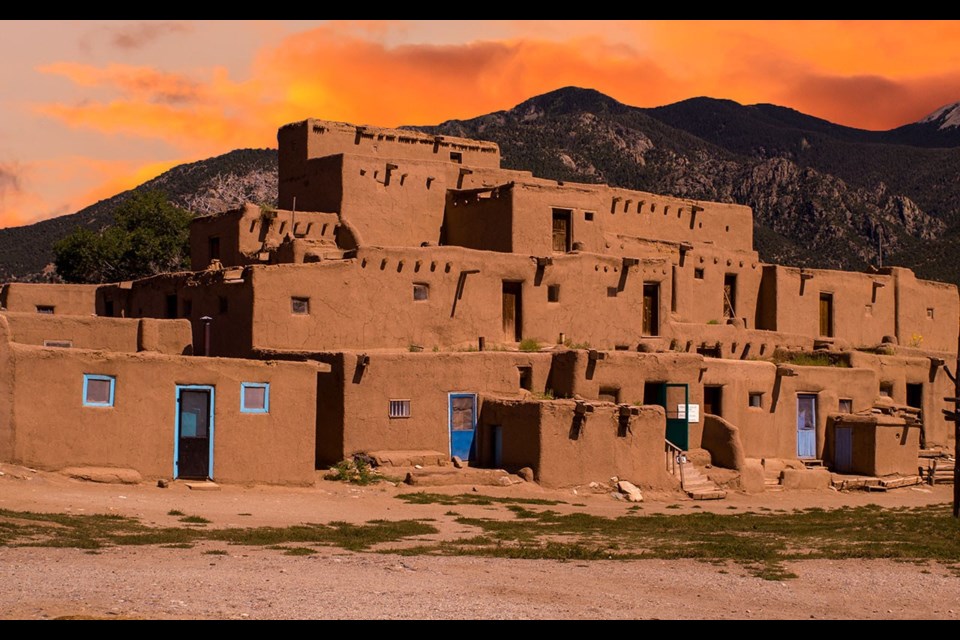Had I grown up Catholic, like my companion, I might have more quickly seen what she saw inside the church at the Taos Pueblo.
The Taos Pueblo is said to be the oldest, continuously inhabited town in North America, perhaps 1,000 years old. The pueblo, which is up to four storeys high, is made of adobe, the walls a metre thick. Wooden ladders, not stairs, provide access to the upper levels. There is no electricity, no running water, no plumbing. Also, no concrete or asphalt. You need to jump puddles, just as the cross-bearing priests who accompanied the Spanish conquistadores surely did upon their arrival in 1615.
The altar of the Catholic church, also made of adobe, is what is most remarkable. Jesus is on the side, secondary to the figure of Mary, the divine feminine, located in a grotto, surrounded by corn. Cathy, my companion, explained that corn pollen is considered sacred, as a way to bless things. In her view, the Pueblo people had converted to Catholicism, but in doing so, they reinterpreted and localized the religion.
That is Taos, a place where the past sort of hangs in air. It is one of the continent's oldest crossroads, a place where trapper and traders, Native Americans and Spanish, all came and went. Today, it remains a place of melding cultures.
We had spent two days at Taos Ski Valley, located 32 kilometres away and 700 metres higher. The ski area is yodely, befitting Its founding by Swiss immigrant Ernie Blake and its location at the intersection of montane (cool, moist, upland slopes below timberline) and alpine environments. But Taos Ski Valley nods frequently to the local context in the high desert below.
Artists have been arriving at Taos since the late 19th century. Having made his mark in New York and Paris, Ernest Blumenschein and another artist who arrived in a horse-drawn wagon from Denver in 1898, planning only to visit but then electing to stay.
"The month was September, and the fertile valley a beautiful sight, and inspiration for those who ply the brush for happiness," he wrote. "The primitive people of this out-of-the-way region were harvesting their crops by sunlight and by moonlight. Brown people they were, both Mexicans and Indians, happy people with happy children, in a garden spot protected by mountains."
Others followed: D.H. Lawrence, better known for his writing about Lady Chatterley but a painter, too, and then the photographer Ansel Adams and, perhaps best known, through the distance of time, Georgia O'Keeffe.
Museums tell some of this history, but abundant galleries testify that the artists have not yet stopped coming. This is a town consumed by art, still captivated by the light and shadows of the high desert and mountain backdrop, a place of smiles and darkness, shades and shapes.
My greatest interest is Western history. Taos was a destination long before Mormons arrived in Utah or the 49ers to California. Fur trappers congregated here, among them Kit Carson. His name remains attached to geography from California to Colorado: including the state capital of Nevada, Carson City, located a half-hour from Lake Tahoe, and one of Colorado's highest peaks, Kit Carson.
Carson had three wives, the first an Arapaho woman who died in childbirth, the second a Cheyenne woman who divorced him in the manner of her people, by putting his stuff outside the teepee. His most enduring marriage was to a Spanish-Mexican woman, Josefa. They are buried side by side in a cemetery in Taos. I paid my respects.
This art and this history define Taos, the town. It's near a ski area, but not a ski town. But we stayed at a bed-and-breakfast called the Inn at La Loma Plaza owned by two former ski-town mayors.
Peggy Osterfoss was mayor of Vail and Jerry Davis of Avon, at the base of Beaver Creek, when they began dating in the 1990s. They chose to sink new roots at Taos, and I may never have had a more pleasant breakfast than in their sunroom, feasting on an omelet that Peggy made herself. The green chile that flavoured it will henceforth make every other omelet seem like cardboard.
Taos is not nearly as big as Santa Fe, located about an hour south, nor does it have the same wealth. It is, however, just as interesting, maybe more so, and if you're a foodie, you may just think you've gone to Southwestern heaven.




